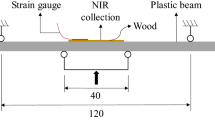Abstract
The non-destructive evaluation of wood properties by Near Infrared Reflectance Spectroscopy (NIR) has been assessed. The surfaces of specimens of clear wood (Picea abies) were NIR-scanned, and the results compared to such properties as moisture content, density, compression strength and chemical and biological degradation. In addition, the NIR-scans of clear wood specimens were compared to the bending strength of the structural timber from which it had been cut. The NIR dependency of surface roughness was investigated and found to be of minor importance.
NIR calibrations for moisture content (MC<30%), density, compression strength and chemical degradation proved that the NIR technique is an excellent non-destructive method (r 2≧0.9; independent test set). Even biological degradation was determined with a most promising accuracy (r 2=0.75; independent test set). For the prediction of the bending strength of timber NIR proved less efficient. However, NIR still contributed to timber strength prediction at the same level as annual ring width, the parameter which is presently visually assessed by timber graders.
It is concluded that the NIR method is very versatile in the non-destructive evaluation of wood. The results merit further investigations in order to develop proper models and instrumentation for commercial use.
Zusammenfassung
Die Möglichkeit, Holzeigenschaften mit Hilfe der zerstörungsfreien NIR-Spektroskopie zu bestimmen, wurde überprüft. Die Oberfläche von fehlerfreiem Fichtenholz wurde mittels NIR abgetastet. Die Meßwerte wurden zu folgenden Holzeigenschaften in Beziehung gebracht: Feuchte, Druckfestigkeit, Dichte sowie chemischen und biologischem Abbau. Zusätzlich wurden die NIR-Ergebnisse noch verglichen mit der Biegefestigkeit des Bauholzes aus dem die Proben entnommen worden waren. Auch die Rauheit der Holzoberflächen wurde mit einbezogen. Sie erwies sich als rel. unbedeutend. Die NIR-Messungen erwiesen sich als hochkorreliert (r 2≧0,9) mit der Feuchte (MC<30%), der Dichte, der Druckfestigkeit und dem Abbaugrad (durch Chemikalien), so daß die NIR-Technik als vorzügliche zerstörungsfreie Bestimmungsmethode anzusehen ist. Sogar der biologische Abbau konnte mit vielversprechender Genauigkeit (r 2=0,75) bestimmt werden. Für die Vorhersage der Biegefestigkeit des Bauholzes war die NIR-Methode weniger geeignet. Immerhin erlaubt die NIR-Technik das Abschätzen der Biegefestigkeit mit der gleichen Zuverlässigkeit wie das Abschätzen der Jahrringbreiten, wie es zur Zeit noch bei der visuellen Holzsortierung benutzt wird. Die NIR-Spektroskopie erweist sich als vielseitig nutzbare Methode zum zerstörungsfreien Ermitteln von Holzeigenschaften. Die Ergebnisse ermutigen weitere Untersuchungen, um daraus geeignete Modelle und Geräte für industrielle Anwendungen zu entwickeln.
Similar content being viewed by others
6 References
Birkett, M. D.;Gambino, M. J. T. 1989: Estimation of pulp kappa number with near-infrared spectroscopy. Tappi Journal 72 (9): 193–197
Easty, D. B.;Berben, S. A.;DeThomas, F. A.;Brimmer, P. J. 1990: Nearinfrared spectroscopy for the analysis of wood pulp: quantifying hardwood-softwood mixtures and estimating lignin content. Tappi Journal 73 (10): 257–261
Hoffmeyer, P. 1990: Failure of wood as influenced by mositure and duration of load. Doctoral dissertation. State University of N. Y., College of Environmental Sci. and Forestry, Syracuse.
Hoffmeyer, P. 1992: Evaluation of wood by near infrared reflectance spectroscopy. Proceedings of IUFRO-Timber Engineering meeting, Bordeaux and Nancy. Building Materials Laboratory. Technical University of Denmark
Kniest, C. 1992: Charakterisierung von Span-Leim-Gemischen mittels NIT-Spektroskopie. Holz Roh-Werkstoff 50: 73–78.
Mroczyk, W. B.;Kasprzyk, H.;Gawecki, T. 1992: The application of NIRS for the determination of the composition of wood samples ofFagus silvatica. pp 566–568 in I. Murray & I. A. Cowe, ed. Making Light Work: Advances in Near Infrared Spectroscopy. VCH Verlagsgesellschaft, Weinheim
Murray, Ian; Cave, Ian A. 1992: Making light work. Advances in near infrared spectroscopy. ISBN 3-527-28498-2, ISBN 1-56081-264-8, pp 566–576
Nair, P.;Lodder, R. A. 1993: Near-IR Identification of Woods for Restoration of Historic Buildings and Furniture. Applied Spectroscopy 47 (3): 287–291
Niemz, P.;Körner, S.;Wienhaus, O.;Flamme, W.;Balmer, M. 1992: Orientierende Untersuchungen zur Anwendung der NIR-Spektroskopie für die Beurteilung des Mischungverhältnisses Laubholz/Nadelholz und des Klebstoffanteils in Spangemischen. Holz Roh-Werkstoff. 50: 25–28
Pedersen, J. G.; Hoffmeyer, P.; Jacobsen, U. G.; Reffstrup, T. 1993: Non-destructive evaluation of wood by near infrared reflectance spectroscopy. Report no. 93-1-1, Biotechnological Institute, Kolding, Denmark
Schultz, T. P.;Burns, D. A. 1992: Rapid secondary analysis of lignocellulose: comparison of near infrared (NIR) and fourier transform infrared (FTIR). Tappi Journal 73 (5): 209–212
Tsuchikawa, S.; Hayashi, K.; Tsutsumi, S. 1992: Application of NIRS to wood. pp 569–576 in: Murray, I.; Cowe, I. A.: Making Light Work: Advances in Near Infrared Spectroscopy. Weinheim 1992
Wallbäcks, L.;Edlund, U.;Nordén, B.;Iversen, T. 1991a. Multivariate characterization of pulp. Part 1. Spectroscopic characterization of physical and chemical differences between pulps using13C, CP/MAS, NMR, FT-IR, NIR and multivariate data analysis. Nordic Pulp and Paper Research Journal 6 (2): 74–80, 94
Wallbäcks, L.;Edlund, U.;Nordén, B.;Iversen, T. 1991b: Multivariate characterization of pulp. part 2. Interpretation and prediction of beating processes. Ibid. 6(3): 104–109
Author information
Authors and Affiliations
Rights and permissions
About this article
Cite this article
Hoffmeyer, P., Pedersen, J.G. Evaluation of density and strength of Norway spruce wood by near infrared reflectance spectroscopy. Holz als Roh-und Werkstoff 53, 165–170 (1995). https://doi.org/10.1007/BF02716418
Issue Date:
DOI: https://doi.org/10.1007/BF02716418




